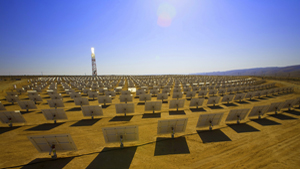Dec 28 2010
With regard to Renewable energy sources, the spotlight is always on the sun, as wind, biomass and other sources are derived from the sun. But, solar energy faces a unique set of problems as it is converted into electricity, which cannot be stored or transported. This explains why biofuels are being researched and electricity is used to produce hydrogen, which in turn is causing a host of other problems.
In the Science publication's current issue, an article has been described in depth about solar energy systems and the problems they face. The creators have demonstrated an equipment, which has the capacity to absorb solar energy and use it to split water into oxygen and hydrogen. It could also do the same on CO2, converting them to carbon monoxide and oxygen. The advantage is that no exotic catalyst is required for completing the process only Cerium, which is a commonly available and stable element is used.
The device includes a focusing lens, which directs the sunlight through a window made from transparent quartz into a reaction chamber. The chamber's design is capable of internal reflection, and captures the photons efficiently. According to the authors, the dimensions enable multiple internal reflections, and capture the incoming solar energy efficiently with an absorption capacity of more than 0.94 which is almost the ideal blackbody limit.
 Solar Thermal
Solar Thermal
After absorption the photons get converted into heat with temperatures rising at 140°C a minute till they surpass 1250°C. They then stabilize between 1400 and 1600°C and are hot enough to create a chemical change in the cylinder of porous cerium dioxide, which is the catalyst; the cerium dioxide gives up one of its oxygen atoms. An inert gas is flown over the porous cylinder and the researchers were able to identify a steady flow of oxygen from the device for almost an hour before dropping off.
After the oxygen production stops, the temperature is reduced to 900°C and a reactant such as water vapor is introduced into the chamber by a pump. The cerium oxide then changes back to cerium dioxide, releasing hydrogen rapidly and efficiently in less than ten minutes. If CO2 is pumped in, carbon monoxide is produced. The Authors found that there would be a steep drop in the performance of the device for the first hundred cycles as the cerium oxide rearranges via the repeated heating processes. However, when bigger particles were formed, the performance of the device stabilized and remained constant for up to 400 cycles.
The system also contains a few drawbacks namely the need for a steady supply of inert gas, pure water and CO2. The hardware produces considerable amount of waste heat, which could be harnessed and used. The researchers have designed the hardware for easy bulk manufacturing and industrial scale production.